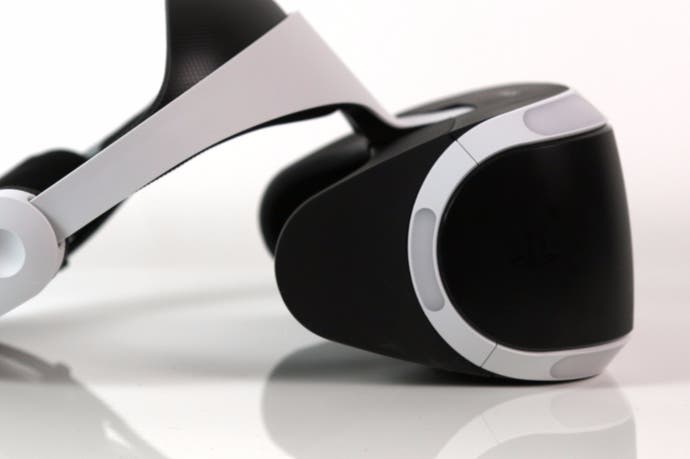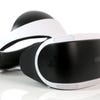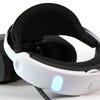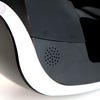Sony PlayStation VR review
Can console technology provide a top-tier virtual reality experience?
The challenge facing Sony with PlayStation VR is immense. The firm doesn't just have to make virtual reality work on a system with nowhere near the same level of horsepower as the PC minimum specification, it has to bring in very expensive hardware at an affordable price-point and it has to integrate VR into the living room - the natural home for the core console. The end result is a masterpiece of hardware design with nips and tucks in (mostly) the right places, backed by a wide range of software that effortlessly propels Sony onto level-footing with established players in the VR field. PlayStation VR isn't perfect, but it works.
Principally, it captures the essence of 'presence'. Don the headset and the sensation is very much like you have been transported to another place, whether it's the GCPD rooftop view over Gotham City in Arkham VR, the interior of an Aston Martin Vanquish in DriveClub or the more stylised Tron-like world of Battlezone VR. Of course, base visual quality isn't on par with your existing PlayStation 4 library: compromises are required, but they don't intrude too much on that awesome feeling of 'being there'.
At a technical level, Sony's engineers have ticked all of the boxes, and in many ways, PSVR is an example of how clever thinking and smart design overcomes what some might consider a sub-par spec. The 120Hz 5.7-inch OLED panel has the required real estate to provide a compelling experience, but it does have a significantly lower resolution - 960x1080 per eye - than both Oculus Rift and HTC Vive. Indeed, even Samsung's smartphone-based Gear VR outstrips PSVR in terms of the core pixel count. Also curious is that PSVR has a reduced field of view - a distinct 'binoculars' effect on the periphery. It's not distracting or intrusive, but it is noticeable.
The end result is a presentation that's somewhat blurrier and a touch more constricted than the competition, but curiously, PlayStation VR actually has less of an issue with the off-putting screendoor effect seen on other headsets. Discerning and focusing on individual pixels is actually rather difficult - what PSVR lacks in terms of core resolution is offset by the use of a full RGB panel, as opposed to the pentile arrangements found elsewhere.
In common with all VR solutions right now, the presentation is very soft, but aliasing from the lower resolution is actually just as much a software challenge as it is hardware - several titles in the launch line-up exhibit few 'jaggies' on the display. Hustle Kings, TumbleVR and Danger Ball (one of the VR Worlds mini-games) in particular just look great - examples where good anti-aliasing makes all the difference. On the flipside, titles with bright colours and hard edges - Rigs springs instantly to mind - can show some very obvious artefacting.
In other areas, PlayStation VR is an undoubted masterpiece of design. For starters, it is by far and away the most comfortable VR headset on the market. While it is larger and heavy on the plastic compared to its rivals, it works to move the weight of the headset away from the front of your face, redistributing the heft to your forehead and the back of your head. Unlike Vive and the Rift, there are no heavy duty straps used here to push the screen onto your face. Instead, PSVR works to suspend the display ahead of you, while a push-button mechanism is used to pull the screen closer to or further away from your face. Rubber-effect surrounds are used to block out light from the real world.
Sony also deserves kudos for a design that is best-in-class in terms of comfort for those wearing glasses. Oculus Rift lacks the necessary area to comfortably accommodate spectacles, while Vive has more space but often feels as though your specs are being smashed back into your face. By contrast, PlayStation VR just fits snugly into place. In terms of overall fit and finish, build quality and comfort level, Sony's efforts here put them at the head of the pack - a great reminder of just how good quality Japanese design can be. I wore the PSVR headset for almost 12 hours straight during one day in putting together this review and felt no kind of stress, pressure or headache at all from the hardware.
Initial set-up is relatively easy too. PSVR comes with an external processor box with power, USB and HDMI inputs, with front-facing outputs for the headset along with an additional video feed that pipes through to your HDTV. When the headset isn't used, standard video is sent to your screen as per normal - in effect, it works as a pass-through. The headset's attached cables are actually fairly short, good for desktop usage but otherwise limited, but an extender cable is included in the box for living room VR usage. It's simple to set-up (to the point where Sony has included numbered cables for those easily confused by the various cables) but the end result is an unseemly rat's nest of wires that is difficult to manage effectively.
The headset is enabled via a power button built into an inline remote on the main cable that tethers the HMD to the external processor. Functionality here is joined by the volume buttons, plus a mic mute button - yes, the headset even includes a microphone too. The remote also plays host to a standard 3.5mm stereo jack, where you plug in your headphones. Rather thoughtfully, Sony provides earbuds out of the box and while the firm could have dropped in low quality offerings here, sound reproduction is fairly decent and there's even an appreciable punch in the lower range.

Tracking on a budget - PSVR's weakest link
Not included in the box is the PlayStation Camera, essential in tracking movement via PSVR's various light. In order to keep costs down, PSVR re-uses a couple of pieces of existing Sony technology - and there's the feeling that they are the weaker links in the chain. The camera is fine for desktop use, but its field of view appears somewhat limited in the living room, while the old camera design's lack of an appreciable base or stand can see the device veering off in odd directions based on the slightest movement of its cable. The revised design is the one to get if you need to buy the camera.
Secondly, PlayStation Move is the 3D controller of choice for PSVR. It's a design years ahead of its time, but it is beginning to show its age in terms of tracking quality - there's a degree of jitter here that feels a little unnatural, and there are occlusion problems too. Face away from the camera with the controllers in front of you and Move's bulbous RGB lights can't be tracked. Gyro sensor data is used to fill in the gaps, but it's often woefully inaccurate. I also found that the Moves often moved out of view to the left and right, further emphasising the somewhat restricted FOV from the PlayStation Camera. You quickly adjust, but every time tracking is lost, the immersive feeling is compromised and it can be an issue.
Also worth pointing out is that the camera has limits on its depth range too - there's a sweet spot in the region of 1.5m to 2m away from the camera, but tracking is lost much further beyond that. And this ties into the concept of 'VR in the living room' that Sony really has to master here - there are many titles that don't really need to be standing up, that you can play quite happily lying back on your sofa - DriveClub VR, Battlezone, or any cockpit game for starters - but this doesn't quite work if your coach is situated too far away from your screen (the logical place for camera positioning). The thing is, the games remain playable - it's just that there's a continual nag message on-screen that you can't get rid of.
But in other respects, Sony has made some very smart design choices here. The social screen is simply brilliant. The external processor box takes the right-hand eye view from the HMD feed, crops it significantly then de-warps it and pipes it out to the HDTV via the HDMI passthrough. The presentation looks very rough - low-ish resolution in the centre, becoming much lower the further out you go, but crucially, this allows people outside of VR to see what you're up to - and to get involved. The processor box also has an h.264 decoder built in and a separate gameplay feed can be sent to that, in a smart utilisation of the Remote Play technology. This allows one set of gamers in the 'real world' to play with one viewpoint, while the player in VR gets another view entirely.

Gaming at 120fps: what is asynchronous timewarp?
I was eager to see how PSVR's internal feed actually looks and to confirm how the social screen actually works, so I split off the HMD feed into our new capture set-up and you can see the results below. PSVR supports the same 90Hz refresh as competing VR solutions, but most titles run at 60fps with a system known as asynchronous timewarp, bringing gameplay up to 120fps (the display itself appears to refresh at 119.88Hz for the record). The idea is that the timewarp adds a slight distortion effect to the image based on the latest motion data from the headset, giving a smoother image.
We can confirm that this is indeed the case, but there's still some perceptible ghosting - as you can see by looking to your side when driving at speed in DriveClub. Based on what our captures are showing us, I now understand why - the timewarp isn't attempting to create an intermediate frame. It's not frame-blending or reconstructing intermediate frames as such. It's simply applying a subtle perspective filter based on HMD movement, and if you're holding your head still, the effect doesn't kick in.
And when that happens, the ghosting we see isn't actually a product of the timewarp at all - it's simply the same kind of image blurring you get playing a 30fps game on a 60Hz display, just at double the frame-rate However, if your head is moving, the captures do look eerily like a native 120fps. It's quite fascinating to see the effect broken down on a frame by frame basis. The distortion effect does create artefacts, but only on the very edges of the rendered screen - tucked away in the furthest reaches of peripheral vision and totally invisible in gameplay.
It's an impressive effect overall and it does work, but it does rely strongly on games sustaining 60fps and never dropping. When performance does dip, the ghosting is immediately obvious and impactful on the experience - but it's interesting to note that these observations are based on preview code, and previous issues I've had with titles like the London Heist (a part of VR Worlds) are all but cleared up in the final game. I've played a lot of the launch line-up at this point and frame-rate is solid on every title I've tested. It suggests that Sony's QA team really is strictly enforcing the require frame-rate lock - a good sign.
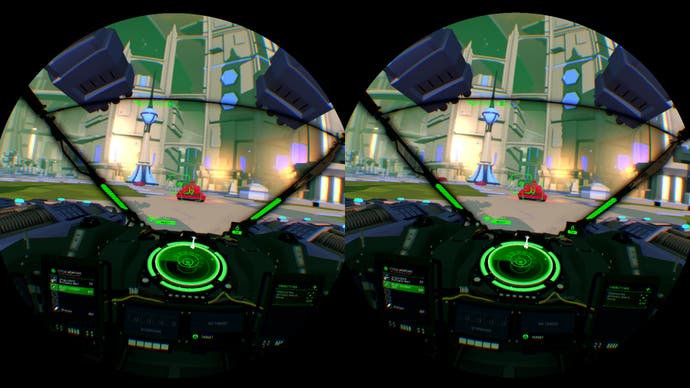
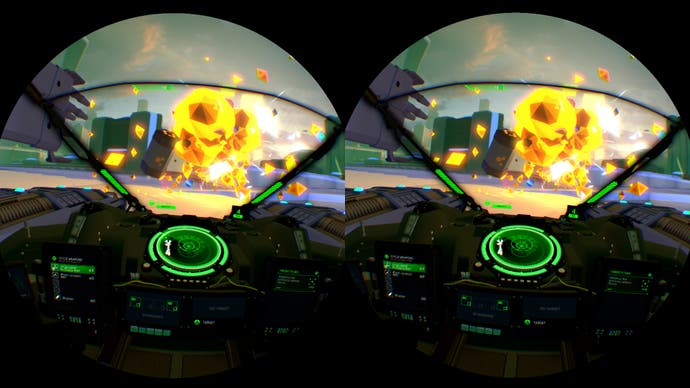


PlayStation VR games: content, value and the nausea question
In terms of the games line-up, there's the sense that Sony is trying to migrate VR beyond the 'tech demo' early stages that have characterised many of the offerings on HTC Vive and Oculus Rift. DriveClub VR and Rigs are full games with price-points to match, while Resident Evil 7 can be played interchangeably between VR and standard '2D' modes. There's also an attempt to bring 'big ticket' franchises to VR too, though many of them do fit more squarely into taster or tech demo territory. We've not seen much of Batman Arkham VR so far because it's very much an 'experience' as opposed to an actual game - and beyond the Batcave level, pretty much everything we can show you is a spoiler, such is the brevity of the core content.
However, at least these smaller titles are mostly fairly priced - a real issue with early Vive and Rift releases. I'd have been happy with a straight port of Super Stardust Ultra, and that is indeed delivered - a kind of stereo 3D Imax version of the original, but the inclusion of a first person tank game, dubbed Invasion, is the icing on the cake and makes the £16 asking price worthwhile. Likewise, Supermassive's Tumble VR is a bargain at £8, while on-rails shooter Until Dawn: Rush of Blood is also decent value.
It's actually the more expensive titles that have difficulty justifying their price-points, because extended play is so challenging - whether it's DriveClub, Battlezone, Rigs or some of the games found in VR Worlds (VR Luge being the most glaring example), there's little attempt to overcome the nausea issue. Any title that exhibits fast in-game motion that isn't reflected in the real world eventually leads to VR fatigue and a distinctly upset stomach. Many Vive titles overcome this by using Room Scale, while Oculus has its comfort ratings - which at least clue you in on what to expect and potentially save you some money in the process. PSVR essentially drops you in at the deep end, though at least the pack-in demo disc gives you some idea of the issues to come.
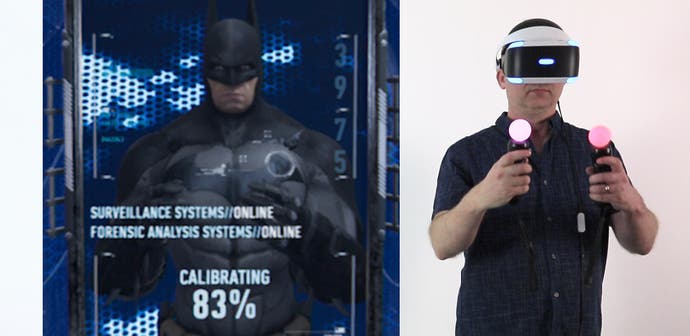
PlayStation VR: the Digital Foundry verdict
The full-fat PC VR experience has been nipped and tucked in terms of core technology and visual accomplishment, but the sense of presence required for a top-tier virtual reality experience is undiminished and there's plenty of promise in the initial launch line-up. Bearing in mind its price in relation to the competition, PlayStation VR is a remarkable achievement - especially bearing in mind that it manages to outscore its much more expensive rivals in key respects, principally in terms of comfort, fit and finish. In accommodating a (relatively) fixed platform, Sony had to get this hardware right first time and by and large, it's done an excellent job.
In terms of recommending a purchase, what's clear is that Sony has managed to overcome most of the principal hurdles, and has handed in a mainstream VR platform for console money that is highly compelling and as much I enjoyed my time with it, there are three significant arguments against investing in it right now, as I see it. First of all, extended gameplay sessions in VR could ultimately prove unsettling on your wellbeing. As relatively inexpensive as it is, will you get the same return from PSVR as a conventional console platform if you're fundamentally limited by the time you can spend using it? And secondly there's the fact that the same financial outlay next month buys you PlayStation 4 Pro. For Sony to release two major pieces of gaming hardware in consecutive months just seems too close.
But perhaps the biggest challenge facing PlayStation VR is that as good as the hardware is overall, the platform - and indeed VR in general - is still looking for that killer app, the game that will change everything. I used to think that presence, that immense feeling of being transported to another place, would be enough to sell the platform, that the experience alone was enough. But what's clear is that it isn't. Virtual reality is an amazing platform and PlayStation VR is a remarkable piece of hardware with many delightful experiences, but what's missing is its Super Mario 64, Halo or Ridge Racer - the 'must have' game that can truly kick off a new generation of interactive entertainment.
